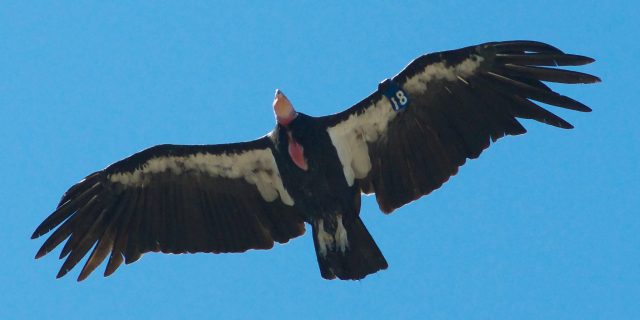31
May
DDT Still Harming Birds of Prey, 50 Years After Its Ban

(Beyond Pesticides, May 31, 2022) Fifty years after the banning of DDT, the notorious insecticide is still harming iconic birds of prey along the California coastline. According to research published in Environmental Science and Technology, California condors and marine mammals along California’s coast are contaminated with several dozen different halogenated organic compounds (hazardous, often-chlorinated chemicals) related to DDT, chlordane, and other now-banned legacy chemicals. The findings highlight the incredible importance of addressing these original “forever chemicals,” and making certain that we do not continue to repeat the mistakes of the past with new and different, yet equally dangerous, chemistries.
Between 1947 and 1971, the Montrose Chemical Corporation of California, the largest historical producer of DDT, released over 1,700 tons of DDT into the LA sewer system, which eventually made its way into the Pacific Ocean. During this time, several other companies discharged PCBs, leading to further chemical contamination of land and sediment. As recent as April 2021, scientists discovered 25,000 barrels likely containing DDT near Catalina Island along the southern California coast.
These releases have resulted in serious environmental and health problems throughout the coastal food chain. Yet, as the present study shows, scientists are only beginning to understand the far-reaching effects.
DDT and similar halogenated organic compounds present significant risks to bird populations. Throughout the 1960s, populations of birds of prey declined precipitously throughout the United States, similar to the serious pollinator decline that is currently being experienced with the continued use of neonicotinoid insecticides. DDT biomagnifies up the food chain; the chemical does not break down, and as each animal progressively up the food chain consumes contaminated prey, the amount of the chemical accumulates, increasing the toxicity to predators at the top. Birds that consume high amounts of fish and other marine organisms contaminated with DDT are more likely to experience egg shell thinning. Thin eggs crack and become nonviable in the nest, which resulted in a widespread failure to procreate among birds of prey during the middle of the 20th century.
By 1987, only 27 California condors remained in existence. It has taken 40 years of captive breeding to grow the population to its current level of 537, yet as the present study highlights, the same threats still remain. “The abundance is so high in Southern California,” said Eunha Hoh, PhD, study coauthor and researcher at San Diego State’s School of Public Health to the LA Times. “We can’t just move on … our ocean is so much more polluted with DDT.”
Scientists assess the continuing threat of DDT (and DDT-related compound) contamination by comparing blood plasma samples from California condors and coastal marine life located at different locations in California. Using two-dimensional gas chromatography coupled to time-of-flight mass spectrometry, levels of halogenated organic compounds were determined for both inland and coastal California condors, as well as marine mammals (various dolphin species, seals, and California sea lions) from both Baja California, Mexico, and southern California.
In summary, researchers identified 415 unique halogenated organic compounds in tested samples. Nine classes of compounds found, likely related to the past chemical dumping, were unknown to scientists. Coastal condors contained four times greater levels of halogenated compounds than inland condors, and marine mammals along the southern California coast contained levels three times higher than those located in Baja California. For DDT alone, coastal California condors had concentrations in their blood seven times higher than their inland neighbors.
“Our ongoing work has demonstrated that the more years a female condor spends on the coast, and thus likely feeding on marine mammals, the lower the probability her egg will hatch,” said Myra Finkelstein, PhD, an environmental toxicologist at UC Santa Cruz to LA Times.
According to previous reports, thinning eggshells have been seen in coastal California Condors since 2006. These coastal populations have been observed feeding on the carcasses of various marine life, including highly contaminated seals and sea lions. Condors along Big Sur are experiencing hatching success as low as 20-40%, while those farther inland near Tejon are seeing rates of 70-80%. Perhaps the silver lining of the present research is the relatively lower levels of contamination found in Baja California, indicating that location as a possible site for coastal reintroduction.
As we deal with the toxic legacy of long-banned pesticides, we must take steps to stop the chemical disasters currently in the making from the use of new long-lived chemistries. Neonicotinoid insecticides can persist in soils for years, resulting in continuous re-uptake by plants, which pollinators feed upon and subsequently experience lethal or sublethal exposure. PFAS chemicals, the new generation of “forever chemicals,” are ubiquitous in farmland throughout the United States. Clean up and species recovery are decades long affairs that society must take preventative measures to prevent.
Take action today to urge lawmakers to enact real, meaningful reforms to federal pesticide law to ensure that we have the tools necessary to prevent the next man-made ecological crisis. As Rachel Carson wrote, “Can anyone believe it is possible to lay down such a barrage of poisons on the surface of the Earth without making it unfit for all life?”
All unattributed positions and opinions in this piece are those of Beyond Pesticides.
Source: LA Times, Environmental Science and Technology










